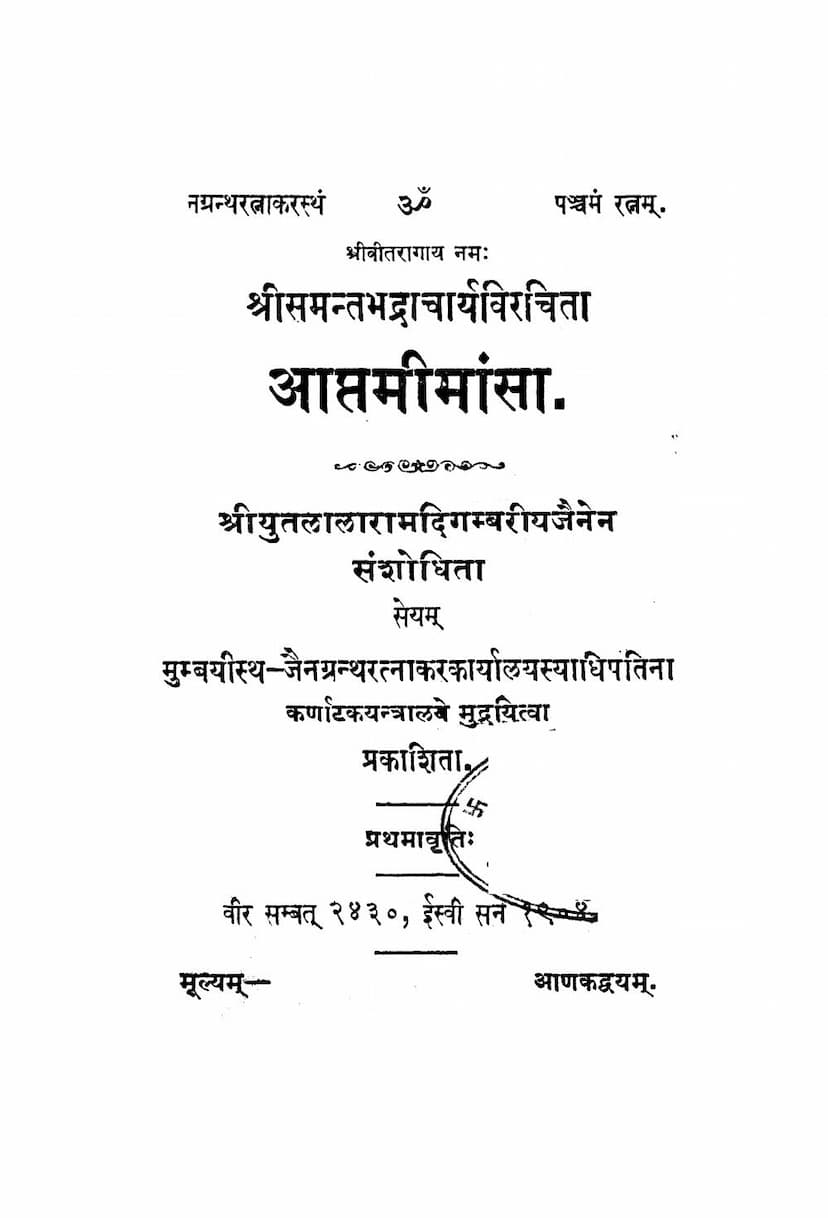Aapt Mimansa
Added to library: September 1, 2025

Summary
This document is a scanned collection of Jain texts, specifically focusing on the works of Acarya Samantabhadra and Acarya Vidyānandi. The primary texts discussed and presented are Āpta Mīmāṃsā and Āpta Parīkṣā.
Here's a comprehensive summary based on the provided pages:
Book Title: Āpta Mīmāṃsā Author: Acarya Samantabhadra Editor/Researched by: Lalaram Digambariya Jain Publisher: Jain Grantharatna Karyalay, Mumbai Publication Year (First Edition): Vira Samvat 2430 (1904 CE)
Introduction to Āpta Mīmāṃsā (Page 2):
- The text highlights that the "Āpta Mīmāṃsā" (also known as Devāgama Stotra or Devāgama Nyāya) is a highly significant stotra (hymn or verse) in Jainism.
- It recounts a historical event where the renowned Naiyāyika (logician) Pātrākeśarī, a non-Jain, was so impressed by hearing this stotra that he immediately converted to Jainism. He later became the esteemed Jain Acharya Vidyānandi.
- Vidyānandi is credited with composing the Aṣṭaśatī commentary on this stotra, and Lāghavasamanta Bhadrācārya wrote a further commentary called Padabhañjikā on the Aṣṭaśatī.
- The text further mentions that Bhatṭālaṅka Deva wrote an Aṣṭaśatī commentary and Acharya Vasunandi wrote a 1000-verse commentary on this very stotra.
- It is stated that this stotra was composed by Acarya Samantabhadra during the time he was writing his extensive commentary (84,000 verses) on the Tattvārtha Sūtra of Vācaka Umasvati.
- The introduction laments the loss of Samantabhadra's magnum opus, the Gandhahasta Mahābhāṣya (on Tattvārtha Sūtra), due to historical atrocities and scholarly animosity towards Jainism.
- The publisher notes that the current edition of Āpta Mīmāṃsā has been collated and corrected from several ancient manuscripts, acknowledging the possibility of errors due to visual defects or limited knowledge, and requests readers to correct them using the commentaries.
Content of Āpta Mīmāṃsā (Pages 3-14):
The provided text includes the original Sanskrit verses of the Āpta Mīmāṃsā, divided into ten paricchedas (chapters or sections). The verses themselves are philosophical and logical in nature, discussing various concepts from a Jain perspective, often refuting opposing philosophical viewpoints. Key themes that emerge from the verse titles and content include:
- Pariccheda 1 (Pages 3-6): Deals with the nature of "Āpta" (the worthy or reliable source of knowledge), questioning claims of greatness based on superficial manifestations. It discusses the paradoxes of existence and non-existence, causality, and the limitations of language in describing reality. It emphasizes the Jain concept of syādvāda (the doctrine of manifold predicaments) and anekānta (non-absolutism).
- Pariccheda 2 (Pages 6-7): Focuses on the concepts of unity and difference, particularly in relation to substances (dravya) and their attributes (guṇa). It critiques non-Jain views on monism and pluralism.
- Pariccheda 3 (Pages 7-9): Discusses the nature of permanence and impermanence (nitya and kṣaṇika), and their implications for action, consequence, and rebirth. It critiques the views of philosophers who hold extreme positions on these matters.
- Pariccheda 4 (Pages 9-10): Addresses the relationship between generalities (sāmānya) and particulars (viśeṣa), and the concepts of cause and effect. It further elaborates on the inadequacy of absolute positions in understanding reality.
- Pariccheda 5 (Page 10): Examines the nature of relative and absolute truth, and the interconnectedness of qualities and their substrata.
- Pariccheda 6 (Page 10-11): Discusses the validity of knowledge, the role of inference (anumāna) and scripture (āgama), and the concept of an "Āpta" as the source of valid knowledge.
- Pariccheda 7 (Pages 11-12): Critiques the reliance on internal (antaranga) or external (bahiranga) factors for knowledge and reality, analyzing the nature of proof and illusion.
- Pariccheda 8 (Page 12): Addresses the interplay between destiny (daiva) and human effort (pauruṣa).
- Pariccheda 9 (Page 12-13): Discusses the concepts of merit (puṇya) and demerit (pāpa), their relation to happiness and suffering, and the nature of bondage and liberation.
- Pariccheda 10 (Pages 13-14): Concludes by emphasizing the Jain path to liberation through right faith, knowledge, and conduct (samyagdarśana, samyakjñāna, samyakcāritra), and the role of the Omniscient (Kevalin) as the true guide. It reiterates the importance of syādvāda and anekānta for understanding the true nature of reality.
Parallel Entry: Āpta Parīkṣā (Pages 17-32):
The document also includes the text of Āpta Parīkṣā, attributed to Acarya Vidyānandi. The introduction (Page 18) provides a similar narrative about Pātrākeśarī's conversion and his subsequent becoming Acarya Vidyānandi, who then authored this Āpta Parīkṣā.
- Āpta Parīkṣā: This text is described as a "parīkṣā" (examination or critique) of the concept of an "Āpta," specifically directed towards refuting the philosophical systems that posit an eternal, omnipotent God (like Brahmanism/Vedanta).
- Key Arguments in Āpta Parīkṣā: The verses critically examine the attributes and actions ascribed to a supreme being. It questions the logical consistency of an omniscient, omnipotent creator who is also unattached to actions and results. It discusses the nature of knowledge, the relationship between soul and body, the paradoxes of eternal existence, and the impossibility of an uncaused cause in the context of an absolute creator. It strongly advocates for the Jain understanding of liberation through self-effort and the attainment of omniscience. It systematically refutes various philosophical arguments for the existence of a creator God, highlighting inconsistencies and logical fallacies.
Overall Purpose:
The collection, especially with the inclusion of both Āpta Mīmāṃsā and Āpta Parīkṣā, serves to:
- Preserve and disseminate classical Jain philosophical texts: Highlighting the works of prominent Jain Acaryas.
- Establish the validity of Jain philosophy: By demonstrating its logical rigor and its ability to critique and refute opposing viewpoints.
- Promote understanding of core Jain concepts: Such as syādvāda, anekānta, karma, liberation, and the nature of an "Āpta" (a worthy soul who has attained omniscience and is a source of truth).
- Provide a historical context for the development of Jain logic and epistemology.
The "List of Obtainable Jain Logic and Philosophy Books" on page 32 and 16 further indicates the publisher's commitment to making these important Jain texts available to the public.